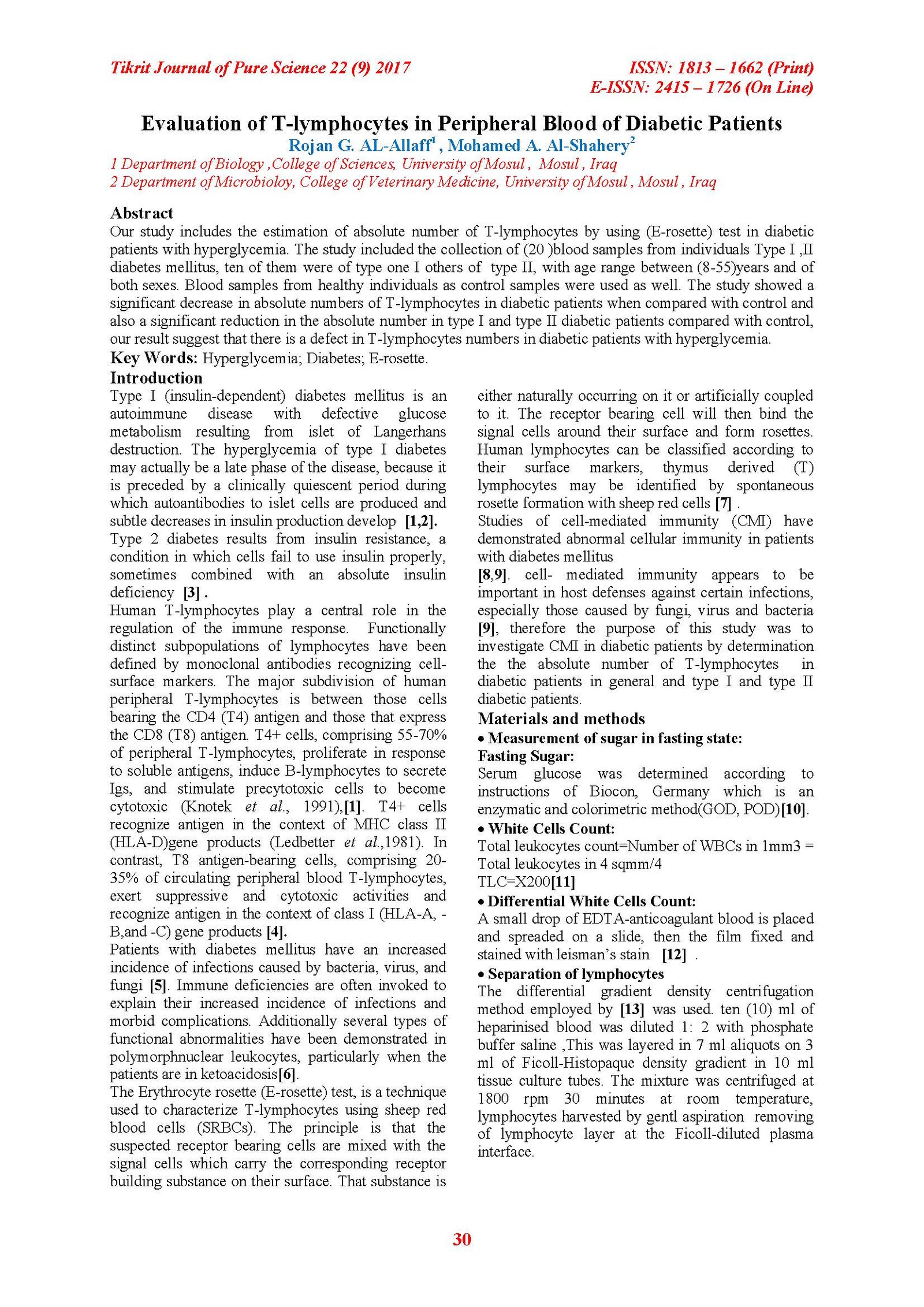Evaluation of T-lymphocytes in Peripheral Blood of Diabetic Patients
Main Article Content
Abstract
Our study includes the estimation of absolute number of T-lymphocytes by using (E-rosette) test in diabetic patients with hyperglycemia. The study included the collection of (20 )blood samples from individuals Type I ,II diabetes mellitus, ten of them were of type one I others of type II, with age range between (8-55)years and of both sexes. Blood samples from healthy individuals as control samples were used as well. The study showed a significant decrease in absolute numbers of T-lymphocytes in diabetic patients when compared with control and also a significant reduction in the absolute number in type I and type II diabetic patients compared with control, our result suggest that there is a defect in T-lymphocytes numbers in diabetic patients with hyperglycemia.
Article Details

This work is licensed under a Creative Commons Attribution 4.0 International License.
Tikrit Journal of Pure Science is licensed under the Creative Commons Attribution 4.0 International License, which allows users to copy, create extracts, abstracts, and new works from the article, alter and revise the article, and make commercial use of the article (including reuse and/or resale of the article by commercial entities), provided the user gives appropriate credit (with a link to the formal publication through the relevant DOI), provides a link to the license, indicates if changes were made, and the licensor is not represented as endorsing the use made of the work. The authors hold the copyright for their published work on the Tikrit J. Pure Sci. website, while Tikrit J. Pure Sci. is responsible for appreciate citation of their work, which is released under CC-BY-4.0, enabling the unrestricted use, distribution, and reproduction of an article in any medium, provided that the original work is properly cited.
References
1- Mac Cuish, A.; Irvine, W.; Barnes, E.; Duncan,
L.(1974). Antibodies to pancreatic islet cells in
insulin-dependent diabetics with coexistent
autoimmune disease. Lancet 2:1529-31.
2- Ganda, O.P.; Srikanta, S.; Brink ,S.J.; Morris,
M.A.; Gleason, R.E.; Soeldner, J.S.; Eisenbarth,
G.S.(1984) Differential sensitivity to p-cell
secretagogues in "early, "type I diabetes mellitus.
Diab.33:516-21.
3-Dubois, H.F.; Bankauskaite, V.(2005). Type 2
diabetes programmers in Europe. Euro Observer 7:
5–6.
4-Ledbetter, J.; Evans, R.;Lipinski, M.; Cunningham-
Rundles, C.; Good, R.; Herzenberg, L. (1981)
Evolutionary conservation of surface molecules that
distinguish T lymphocyte helper/ inducer and
cytotoxic/suppressor subpopulations in mouse and
man. J Exp Med 153:310-23.
5- Habib, A.G.; Gebi, U.I.; Sani, B.G.; Maisaka,
M.U.; Oyeniyi, T.; Musa, B.O.; Onyemelukwe, G.C.
(2008). Insulin dependent diabetes mellitus
complicating follicular lymphoma in an adult
Nigerian: immunobiological aspects. Intern. Diab.
Dig.; 7:334.
6- Ifere, O.G.(2009). Lymphocytes membrane protein
glycosylation: a possible cause of lowered immunecompetence
in diabetic subjects. Diab. Intern; 10:14-
15.
7- Jondal, M.; Holm, G.; Weigzell, H. (1972).
Surface markers on human T and B lymphocytes. J.
Exp. Med. J Exp Med, 1972; 136: 207-215.
8- Bagdade, J. D; Bulger. R. J. (2004). Impaired
leukocyte function in patients with poorly controlled
diabetes. Diab; 23:9-15.
9- Perillie, P. E.; Nolan, J. P. and Finch, S. C. (2000).
Studies of the resistance to infection in diabetes
mellitus: local exudative cellular response. J. Lab.
Clin. Med.; 59:1008-1015.
10-Tietz, N.W. (1995). Textbook of Clinical
Chemistry. 3ed. C.A. Curtis, E.R. Silverman, L.M.,
Christensen, R.H. pp:523-524.
11-Lewis, S.A.; Bain, B.J.(2001). Dacie and lewis
practical haematology harcount publishers limited.
9th.ed.,pp 320.
12-Mckenzie, S.B. (1996). Textbook Of Hematology.
2eded., Williams and Wilkins, A Waverly company.
U.S.A. pp: 605-607.
13-Musa, B.O.P.; Onyemelukwe, G.C.; Hambolu,
J.O.; Bakari, A.G.; Anumah F.E. (2010). Cellmediated
immunity in type 2 diabetes mellitus
patients in diabetic ketoacidosis, patients with
controlled type2 diabetes mellitus and healthy control
subjects. J. Medicine and Med. Sci.1(7)pp: 290-295
©2010 international research Journals.
14-Knotek, Z.; Vojttsek, P.; Petra ladkov, A; Hoihn,
F; Kovai, O.; Madr, P.; Drabek, J.(1991).A simple
and efficient variant of the E- rosette test for the
detection of T- lymphocytes in pigs. J. Acta. Vet.
Brno.,80, pp:231-236.
15-VonKänel, R.; Mills, P.J.; Dimsdale, J.E.(2001).
Short-term hyperglycemia induces lymphopenia and
lymphocytes subset redistribution. J. Life Sci.2001
june 8;69(3):255-62.
16-Nerup, J.; Platz, P.; Andersen, O.O.; Christy, M.;
lyngsøe, J.; poulsen, J.E.; Ryder, L.P.; Nielsen, L.S.;
Thomsen, M.; Sveigaard, A. (1974). HLA antigen
and diabetes mellitus. J. Lancet. 2:864-66.
17- Mac Cuish, A.C.; Urbaniak, S.J.; Cambell, C.J.;
Duncan, L.J.P.; Irvine, W.J. (1974).
Phytohemagglutinin transformation and circulating
lymphocyte subpopulation in insulin-dependent
diabetic patients. J. Diab.23:708-12.
18- Pometkin, V.V.; Nikonova, T.V.; Brykova, S.V.
(1994). Dynamics of a series of parameter of cellular
and humoral immunity in patients with diabetes
mellitus type1. J.probl Endokrinal. (Mosk) 40(6)pp:5-
7.
19- Tujino, M.; Kinpara, I.; Nakamura, T.; Suda, T.;
Saitou, Y.; Kudou, H. (1996). Peripheral lymphocytes
subset of paitents with pancreatic diabetes mellitus –
about adecreased ratio of T- LGL and ability of host
defense. J. Kansenshogaku Zasshi .70(4):325-30.
20- Karachunskii, M.A.; Gergert, VIA.; Lakovleva,
O.B. (1997).Specific features of cellular immunity of
pulmonary tuberculosis in patients with diabetes
mellitus. J.Probl. Tuberk.(6)pp:56-60.
21-Tsukaguchi, K.; Okamura, H.; Ikumo, M.;
Kobayashi, A,l.; Fukuoka, A.; Takanaka, H. (1997).
The relation between diabetes mellitus and IFNgamma,
IL12 and IL-10 production by CD+4 alpha
beta T cells and monocytes in patients with
pulmonary tuberculosis. J. Kekkaku.72(11)617-22.
22-Chang, F.Y.; Shaio, M.F.(1995). Decreased cellmediated
immunity in patients with non- insulin
dependent diabetes mellitus. J. Diabetes Res Clin
Pract. 28(2)137-46.
23- Otton, R.; Mendonca, J.R.; Curi, R. (2002).
Diabetes causes marked changes in lymphocytes
metabolism. J. Endocrinology.174,pp:55-61.
24-Otton, R.; Soriano, F.G.; Verlengia, R.; Curi, R.
(2004). Diabetes induces apoptosis in lymphocytes. J.
Endocrinology.182.pp:145-156.
25-Plouffe, J.F.; Silva, J.; Fekety, R.; Allen, J.L.
(1978). Cell mediated immunity
In diabetes mellitus. J. Infection and Immunity.
21(2)pp: 425-429.
